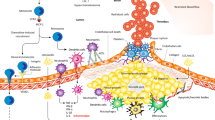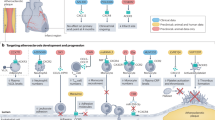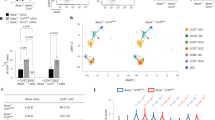Abstract
Atherosclerosis is currently considered an inflammatory disease. Much attention has been focused on the potential role of inflammatory mediators as prognostic/diagnostic markers or therapeutic targets of atherosclerotic cardiovascular disease. CX3CL1 (or fractalkine) is a structurally and functionally unique chemokine with a well documented role in atherosclerosis. In its membrane bound form it promotes the firm adhesion of rolling leucocytes onto the vessel wall, while in its soluble form it serves as a potent chemoattractant for CX3CR1-expressing cells. Additionally, CX3CL1 exerts cytotoxic effects on the endothelium as well as anti-apoptotic and proliferative effects on vascular cells, affecting the context and stability of the atherosclerotic plaque. Studies on animal models have shown that the blockade of the CX3CL1/CX3CR1 pathway ameliorates the severity of atherosclerosis, while genetic epidemiology has confirmed that a genetically-defined less active CX3CL1/CX3CR1 pathway is associated with a reduced risk of atherosclerotic disease in humans. Although several studies support an important pathogenic role of CX3CL1/CX3CR1 in atherogenesis and plaque destabilization, this does not necessarily suggest that this pathway is a suitable therapeutic target or that CX3CL1 can serve as a prognostic/diagnostic biomarker. Further studies on the CX3CL1/CX3CR1 chemokine pathway are clearly warranted to justify the clinical relevance of its role in atherosclerosis.
Similar content being viewed by others
Log in or create a free account to read this content
Gain free access to this article, as well as selected content from this journal and more on nature.com
or
References
Mirzaei M, Truswell AS, Taylor R, Leeder SR . Coronary heart disease epidemics: not all the same. Heart 2009; 95: 740–6.
European Heart Network. European cardiovascular disease statistics. 2008 edition.
Ross R . Atherosclerosis — an inflammatory disease. N Engl J Med 1999; 340: 115–26.
Ross R, Glomset JA . The pathogenesis of atherosclerosis (second of two parts). N Engl J Med 1976; 295: 420–5.
Ross R, Glomset JA . The pathogenesis of atherosclerosis (first of two parts). N Engl J Med 1976; 295: 369–77.
Weber C . Chemokines in atherosclerosis, thrombosis, and vascular biology. Arterioscler Thromb Vasc Biol 2008; 28: 1896.
Luster AD . Chemokines — chemotactic cytokines that mediate inflammation. N Engl J Med 1998; 338: 436–45.
IUIS/WHO subcommittee on chemokine nomenclature. Chemokine/chemokine receptor nomenclature. Cytokine 2003; 21: 48–9.
Jin T, Xu X, Hereld D . Chemotaxis, chemokine receptors and human disease. Cytokine 2008; 44: 1–8.
Comerford I, Nibbs RJ . Post-translational control of chemokines: a role for decoy receptors? Immunol Lett 2005; 96: 163–74.
Apostolakis S, Chalikias GK, Tziakas DN, Konstantinides S . Erythrocyte Duffy antigen receptor for chemokines (DARC): diagnostic and therapeutic implications in atherosclerotic cardiovascular disease. Acta Pharmacol Sin 2011; 32: 417–24.
Cushing SD, Berliner JA, Valente AJ, Territo MC, Navab M, Parhami F, et al. Minimally modified low density lipoprotein induces monocyte chemotactic protein 1 in human endothelial cells and smooth muscle cells. Proc Natl Acad Sci U S A 1990; 87: 5134–8.
Weber C, Schober A, Zernecke A . Chemokines: key regulators of mononuclear cell recruitment in atherosclerotic vascular disease. Arterioscler Thromb Vasc Biol 2004; 24: 1997–2008.
Barlic J, Murphy PM . Chemokine regulation of atherosclerosis. J Leukoc Biol 2007; 82: 226–36.
Apostolakis S, Vogiatzi K, Amanatidou V, Spandidos DA . Interleukin 8 and cardiovascular disease. Cardiovasc Res 2009; 84: 353–60.
Apostolakis S, Amanatidou V, Spandidos DA . Therapeutic implications of chemokine-mediated pathways in atherosclerosis: realistic perspectives and utopias. Acta Pharmacol Sin 2010; 31: 1103–10.
Bazan JF, Bacon KB, Hardiman GJ . A new class of membrane bound chemokine with a CX3C motif. Nature 1997; 385: 640–4.
Haskell CA, Cleary MD, Charo IF . Unique role of the chemokine domain of fractalkine in cell capture. Kinetics of receptor dissociation correlate with cell adhesion. J Biol Chem 2000; 275: 34183–9.
Imai T, Hieshima K, Haskell C, Baba M, Nagira M, Nishimura M, et al. Identification and molecular characterization of fractalkine receptor CX3CR1, which mediates both leukocyte migration and adhesion. Cell 1997; 91: 521–30.
White GE, Greaves DR . Fractalkine: a survivor's guide: chemokines as antiapoptotic mediators. Arterioscler Thromb Vasc Biol 2012; 32: 589–94.
Wong BW, Wong D, McManus BM . Characterization of fractalkine (CX3CL1) and CX3CR1 in human coronary arteries with native atherosclerosis, diabetes mellitus, and transplant vascular disease. Cardiovasc Pathol 2002; 11: 332–8.
Lucas AD, Bursill C, Guzik TJ, Sadowski J, Channon KM, Greaves DR . Smooth muscle cells in human atherosclerotic plaques express the fractalkine receptor CX3CR1 and undergo chemotaxis to the CX3C chemokine fractalkine (CX3CL1). Circulation 2003; 108: 2498–504.
Stolla M, Pelisek J, von Brühl ML, Schäfer A, Barocke V, Heider P, et al. Fractalkine is expressed in early and advanced atherosclerotic lesions and supports monocyte recruitment via CX3CR1. PLoS One 2012; 7: e43572.
Shah R, Hinkle CC, Ferguson JF, Mehta NN, Li M, Qu L, et al. Fractalkine is a novel human adipochemokine associated with type 2 diabetes. Diabetes 2011; 60: 1512–8.
Combadiere C, Potteaux S, Gao JL, Esposito B, Casanova S, Lee EJ, et al. Decreased atherosclerotic lesion formation in CX3CR1/apolipoprotein E double knockout mice. Circulation 2003; 107: 1009–16.
Lesnik P, Haskell CA, Charo IF . Decreased atherosclerosis in CX3CR1−/− mice reveals a role for fractalkine in atherogenesis. J Clin Invest 2003; 111: 333–40.
Saederup N, Chan L, Lira SA, Charo IF . Fractalkine deficiency markedly reduces macrophage accumulation and atherosclerotic lesion formation in CCR2−/− mice: evidence for independent chemokine functions in atherogenesis. Circulation 2008; 117: 1642–8.
Combadière C, Potteaux S, Rodero M, Simon T, Pezard A, Esposito B, et al. Combined inhibition of CCL2, CX3CR1, and CCR5 abrogates Ly6C(hi) and Ly6C(lo) monocytosis and almost abolishes atherosclerosis in hypercholesterolemic mice. Circulation 2008; 117: 1649–57.
Liu H, Jiang D, Zhang S, Ou B . Aspirin inhibits fractalkine expression in atherosclerotic plaques and reduces atherosclerosis in ApoE gene knockout mice. Cardiovasc Drugs Ther 2010; 24: 17–24.
Schäfer A, Schulz C, Eigenthaler M, Fraccarollo D, Kobsar A, Gawaz M, et al. Novel role of the membrane-bound chemokine fractalkine in platelet activation and adhesion. Blood 2004; 103: 407–12.
Schulz C, Schäfer A, Stolla M, Kerstan S, Lorenz M, von Brühl ML, et al. Chemokine fractalkine mediates leukocyte recruitment to inflammatory endothelial cells in flowing whole blood: a critical role for P-selectin expressed on activated platelets. Circulation 2007; 116: 764–73.
Liu H, Jiang D . Fractalkine/CX3CR1 and atherosclerosis. Clin Chim Acta 2011; 412: 1180–6.
Yadav AK, Lal A, Jha V . Association of circulating fractalkine (CX3CL1) and CX3CR1(+)CD4(+) T cells with common carotid artery intima-media thickness in patients with chronic kidney disease. J Atheroscler Thromb 2011; 18: 958–65.
Yadav AK, Sharma V, Jha V . Association between serum neopterin and inflammatory activation in chronic kidney disease. Mediators Inflamm 2012; 2012: 476979.
Njerve IU, Pettersen AÅ, Opstad TB, Arnesen H, Seljeflot I . Fractalkine and its receptor (CX3CR1) in patients with stable coronary artery disease and diabetes mellitus. Metab Syndr Relat Disord 2012; 10: 400–6.
Maegdefessel L, Schlitt A, Pippig S, Schwaab B, Fingscheidt K, Raaz U, et al. Patients with insulin-dependent diabetes or coronary heart disease following rehabilitation express serum fractalkine levels similar to those in healthy control subjects. Vasc Health Risk Manag 2009; 5: 849–57.
Li J, Guo Y, Luan X, Qi T, Li D, Chen Y, et al. Independent roles of monocyte chemoattractant protein-1, regulated on activation, normal T-cell expressed and secreted and fractalkine in the vulnerability of coronary atherosclerotic plaques. Circ J 2012; 76: 2167–73.
Damås JK, Boullier A, Waehre T, Smith C, Sandberg WJ, Green S, et al. Expression of fractalkine (CX3CL1) and its receptor, CX3CR1, is elevated in coronary artery disease and is reduced during statin therapy. Arterioscler Thromb Vasc Biol 2005; 25: 2567–72.
Apostolakis S, Krambovitis E, Vlata Z, Kochiadakis GE, Baritaki S, Spandidos DA . CX3CR1 receptor is up-regulated in monocytes of coronary artery diseased patients: impact of pre-inflammatory stimuli and renin-angiotensin system modulators. Thromb Res 2007; 121: 387–95.
Richter B, Koller L, Hohensinner PJ, Rychli K, Zorn G, Goliasch G, et al. Fractalkine is an independent predictor of mortality in patients with advanced heart failure. Thromb Haemost 2012; 108: 1220–7.
Richter B, Koller L, Hohensinner PJ, Zorn G, Brekalo M, Berger R, et al. A multi-biomarker risk score improves prediction of long-term mortality in patients with advanced heart failure. Int J Cardiol 2012; doi: 10.1016/j.ijcard.2012.11.052.
Moatti D, Faure S, Fumeron F, Amara Mel-W, Seknadji P, McDermott DH, et al. Polymorphism in the fractalkine receptor CX3CR1 as a genetic risk factor for coronary artery disease. Blood 2001; 97: 1925–8.
McDermott DH, Halcox JP, Schenke WH, Waclawiw MA, Merrell MN, Epstein N, et al. Association between polymorphism in the chemokine receptor CX3CR1 and coronary vascular endothelial dysfunction and atherosclerosis. Circ Res 2001; 89: 401–7.
Apostolakis S, Amanatidou V, Papadakis EG, Spandidos DA . Genetic diversity of CX3CR1 gene and coronary artery disease: new insights through a meta-analysis. Atherosclerosis 2009; 207: 8–15.
Apostolakis S, Baritaki S, Kochiadakis GE, Igoumenidis NE, Panutsopulos D, Spandidos DA . Effects of polymorphisms in chemokine ligands and receptors on susceptibility to coronary artery disease. Thromb Res 2007; 119: 63–71.
Yoshimura T, Matsushima K, Oppenheim JJ, Leonard EJ . Neutrophil chemotactic factor produced by lipopolysaccharide (LPS)-stimulated human blood mononuclear leukocytes: partial characterization and separation from interleukin 1 (IL 1). J Immunol 1987; 139: 788–93.
Schnabel RB, Baumert J, Barbalic M, Dupuis J, Ellinor PT, Durda P, et al. Duffy antigen receptor for chemokines (Darc) polymorphism regulates circulating concentrations of monocyte chemoattractant protein-1 and other inflammatory mediators. Blood 2010; 115: 5289–99.
Tziakas DN, Chalikias GK, Tentes IK, Stakos D, Chatzikyriakou SV, Mitrousi K, et al. Interleukin-8 is increased in the membrane of circulating erythrocytes in patients with acute coronary syndrome. Eur Heart J 2008; 29: 2713–22.
Author information
Authors and Affiliations
Corresponding author
Rights and permissions
About this article
Cite this article
Apostolakis, S., Spandidos, D. Chemokines and atherosclerosis: focus on the CX3CL1/CX3CR1 pathway. Acta Pharmacol Sin 34, 1251–1256 (2013). https://doi.org/10.1038/aps.2013.92
Received:
Accepted:
Published:
Issue date:
DOI: https://doi.org/10.1038/aps.2013.92
Keywords
This article is cited by
-
Gut microbiota, circulating inflammatory markers and metabolites, and carotid artery atherosclerosis in HIV infection
Microbiome (2023)
-
Implication of IL-7 receptor alpha chain expression by CD8+ T cells and its signature in defining biomarkers in aging
Immunity & Ageing (2022)
-
Implications of fractalkine on glial function, ablation and glial proteins/receptors/markers—understanding its therapeutic usefulness in neurological settings: a narrative review
Future Journal of Pharmaceutical Sciences (2022)
-
The Relationship Between Chemokine and Chemokine Receptor Genes Polymorphisms and Chronic Obstructive Pulmonary Disease Susceptibility in Tatar Population from Russia: A Case Control Study
Biochemical Genetics (2022)
-
Low Shear Stress Upregulates CX3CR1 Expression by Inducing VCAM-1 via the NF-κB Pathway in Vascular Endothelial Cells
Cell Biochemistry and Biophysics (2020)



